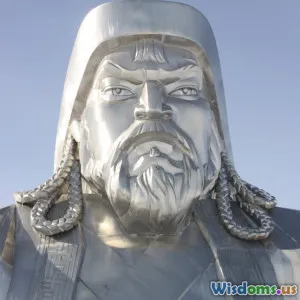
Debunking Myths About Genghis Khan and His Legacy
7 min read Explore truths behind Genghis Khan's legacy, dispelling myths surrounding his life and impact on history. (0 Reviews)
Debunking Myths About Genghis Khan and His Legacy
Genghis Khan remains one of history's most enigmatic figures, renowned for uniting the Mongol tribes and forging an empire that stretched from Asia to Europe. Popular culture often paints him as a ruthless conqueror, synonymous with merciless violence, but this black-and-white image misses the complex reality of his life and legacy. This article dives deep into the most entrenched myths and reveals insights that challenge our understanding of this legendary leader.
Introduction: The Alluring Legend of Genghis Khan
Few names evoke an aura of invincibility and terror quite like Genghis Khan. His reputation as the bloodthirsty ruler who razed cities and slaughtered millions has captivated storytellers, filmmakers, and historians alike. However, beneath the tales of brute force lies a figure far richer in nuance — a visionary who reshaped political, social, and cultural frameworks of his time.
This article aims to shed light on misunderstood aspects of Genghis Khan’s legacy, not to sanitize his history, but to paint a clearer picture based on the latest scholarship and historical evidence.
Myth 1: Genghis Khan Was Only a Ruthless Conqueror
The Brutality Perspective
Historical accounts have often emphasized Genghis Khan’s ruthlessness, citing massacres and the destruction of cities like Nishapur and Urgench. Undeniably, warfare during his campaigns was brutal by modern standards. However, branding him solely as a bloodthirsty tyrant ignores his governance philosophy.
Governance and Laws
Genghis Khan introduced the Yassa, a code of laws aiming for order and stability within his rapidly expanding empire. These laws forbade theft, adultery, and dishonesty, and protected the environment and religious freedoms. His meritocratic system promoted generals and administrators based on ability rather than birthright—a significant departure from the hierarchical norms of the time.
Promoter of Trade and Communication
Beyond warfare, Genghis Khan actively cultivated trade routes such as the Silk Road and developed a sophisticated postal system called the Yam, which enhanced communication across the empire. His reign encouraged merchants and artisans, aiding economic prosperity.
As historian Jack Weatherford notes in Genghis Khan and the Making of the Modern World, “The Mongol Empire was more sophisticated and forward-thinking than many realize.”
Myth 2: Genghis Khan’s Empire Resulted Solely in Destruction
Cultural Exchange and Integration
While the initial military campaigns caused widespread destruction, the Mongol Empire became a melting pot of diverse cultures. Genghis Khan and his successors facilitated the exchange of ideas, technologies, and religions, ultimately creating a culturally rich empire.
For instance, the Mongols embraced and protected multiple religions, including Buddhism, Christianity, Islam, and shamanistic beliefs, allowing religious tolerance at a time when sectarian conflict was common.
Transmission of Knowledge
The Pax Mongolica—the relative peace enforced by the empire—enabled scholars, artists, and scientists to travel freely across Eurasian lands. This led to the transfer of innovations such as papermaking, gunpowder, and compass technology between East and West, fundamentally altering the trajectory of global history.
Myth 3: Genghis Khan’s Descendants Only Continued War and Oppression
Diverse Legacies
Genghis Khan’s descendants established powerful states like the Yuan Dynasty in China and the Ilkhanate in Persia. While military conquest continued, they also fostered remarkable cultural and technological advancements.
The Yuan Dynasty under Kublai Khan saw the construction of major architectural feats and encouraged literature and art. Despite debates about the dynasty's control methods, the integration of Mongol leadership with Chinese bureaucracy demonstrated political adaptability.
Modern Genetic Legacy
On a fascinating note, genetic studies estimate that about 0.5% of the world’s male population—around 16 million men—may be descended from Genghis Khan, reflecting the vastness of his legacy.
This genetic footprint serves as a testament to the profound demographic and historical impact of the Mongol Empire.
Myth 4: Genghis Khan Was Uneducated and Barbaric
Evidence of Strategic Acumen
Genghis Khan was illiterate, but he was a keen strategist and diplomat. His early rise involved savvy alliance-building among Mongol tribes and intelligent exploitation of enemies’ weaknesses.
He sought out skilled advisors, utilized superior military tactics such as feigned retreats and psychological warfare, and implemented extensive intelligence networks. These factors were key to the Mongols’ unexpected successes against established empires.
Emphasis on Literacy and Administration
Though personally illiterate, Genghis encouraged the recording of histories and codification of laws, recognizing the importance of literacy among his officials. Many Mongol elites adapted to existing bureaucracies in conquered regions, synthesizing their governance with local customs.
Conclusion: A Legacy More Complex Than Myth
Genghis Khan’s legacy defies simplistic portrayals as just a warlord or destroyer. Emerging from the steppes as a tribal leader who united fractured clans, he created one of history’s largest contiguous empires with profound political, cultural, and economic influences still felt today.
Understanding the myths and peeling back centuries of legend reveals a multi-faceted leader: a lawgiver, visionary, and agent of globalization long before the term existed. Recognizing the complexities of his reign not only honors historical accuracy but also enriches our appreciation of Eurasian history.
Whether admired or critiqued, Genghis Khan’s story continues to captivate us because it touches on themes of power, culture, and identity that remain relevant today.
Rate the Post
User Reviews
Popular Posts



















